May 6, 2011 | currency, history
The Maryland Colony was founded by George Calvert, the First Baron of Baltimore, when he sailed from Newfoundland to Virginia in 1629. Calvert travelled up the Chesapeake Bay and settled in the area now known as Saint Mary’s City. Calvert applied to Charles I for a charter in 1630 but died in April 1632 before receiving it. On June 20, 1632, Charles I granted a charter for the colony to Cecil Calvert, the Second Baron of Baltimore. Charles I declared that the colony would be called Maryland, named for the Queen Consort Henrietta Maria.
In 1727, King George II named Charles Calvert the Fifth Baron of Baltimore. Charles then appointed himself Maryland’s governor in 1732, succeeding his brother, Benedict Calvert. When Charles took office, the colonial treasury was in need of funding. Charles used his political connections in London, he was granted permission to authorize and fund the first emission of bills of credit in the Maryland colony.
Calvert arranged for the printing of notes in England to replace low quality tobacco leaves that were circulating as ad hoc currency. The notes were issued in denominations based on the British pound sterling of 20 shillings: 1/- (one shilling), 1/6 (one shilling 6 pence), 2/6, 5/-, 10/-, 15/-, and 20/-. The first issue consisted of £90,000 in bills of credit that were issued as legal tender for most debts except for fees due to a minister or an officer. Each taxpayer was to be given 30/- in notes in return for burning 150 pounds of tobacco currency. History does not record why colonists were paid to burn tobacco. The notes were to be redeemed in 1748 with profits through Calvert’s investments in Bank of England stock that was purchased from the proceeds of a tax on tobacco exports. The notes were engraved in England and the paper was watermarked “Maryland.” When issued, the notes were hand dated with two signers.

Following that first issue, the Maryland Assembly voted to issue smaller emissions for specific purposes. For example, £5,000 was authorized in 1740 to help support a British expedition to the Spanish West Indies. This emission used the stock of unused notes from the 1733 issue but was signed with the current date. In 1749, the Maryland Assembly issued £60,000 in new notes, printed in England using the same plates as the 1733 emission except that the words “New Bill” were added below the denomination.
During the French and Indian War, the British government expected the affected colonies to contribute men and money. Royal Governor Horatio Sharpe asked the legislature to loan £2,000 to the war effort, to be used as rewards for enemy scalps. This emission used the same notes that were backed by a tax on carriage and wagon wheels, import duties on wine and rum, import duties on slaves, and license fees for peddlers. A further emission of £40,000 was authorized to pay for soldiers and the building of defenses to protect Maryland colonists. To support the loan, the Assembly added taxes to bachelors, billiard tables, legal documents, land, and also import taxes on horses, pitch, tar, and turpentine. An emission of £650 was authorized to help the British government pay gifts to allied native nations who fought in the war and a £3,000 loan to Virginia to help their reparations for the war.
In my new quest to find an example of every emission of Maryland Colonial currency, I was able to purchase an unused 1733 1 shilling 6 pence note from Heritage Auctions (pictured above, reverse is blank). The note is graded Choice About New 58PPQ by PCGS Currency. This beautiful note survived the 1733 and 1740 emissions and were saved by souvenir hunters when the Maryland Assembly began authorizing Jonas Green of Annapolis to print notes for later emissions. I am really having fun searching for Maryland Colonial notes.
Apr 28, 2011 | currency, review, technology
Following my review of EyeNote from the Bureau of Engraving and Printing, I was contacted Phillip Yang of Ipplex asking if I wanted to look at LookTel Money Reader. LookTel Money Reader is an iPhone application that performs the same functions as EyeNote, but I found to be even better.
According to the LookTel website, the app was developed by Ipplex under sponsorship from the National Institutes of Health (NIH) and was awarded two research grants from the National Eye Institute (NEI) and the National Institute on Aging (NIA). The app was awarded first place at the 2010 CTIA E-Tech Awards for Mobile Applications in the Healthcare category.
I was given a code from Mr. Yang to download the app for free. I did tell let Mr. Yang know that it receiving the app for free would not influence my review. The code was redeemed, downloaded to my iPhone 4, and started testing.
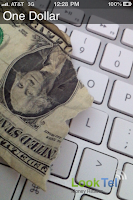 To use Money Reader, you start the app and move the note to be identified in front of the camera—no special positioning or clicking required. First, I grabbed the $1 note that one of my dogs used as a chew toy. Before I was able to situate the iPhone over the note, it caught a piece of it and started to speak, “One Dollar. One Dollar. One Dollar.” While the note is identifiable, Money Reader will speak the denomination until you move the note out of view. I moved the note, turned it over with the same result. The note was turned upside down, folded, moved in sideways, and Money Reader identified the note when about one-sixth of the note covered the screen.
To use Money Reader, you start the app and move the note to be identified in front of the camera—no special positioning or clicking required. First, I grabbed the $1 note that one of my dogs used as a chew toy. Before I was able to situate the iPhone over the note, it caught a piece of it and started to speak, “One Dollar. One Dollar. One Dollar.” While the note is identifiable, Money Reader will speak the denomination until you move the note out of view. I moved the note, turned it over with the same result. The note was turned upside down, folded, moved in sideways, and Money Reader identified the note when about one-sixth of the note covered the screen.
To say I was impressed with Money Reader’s performance would be an understatement. I had to try more. Using the money in my pocket, the app identified each note. It did not matter whether I used the front, back, turned the note upside down, sideways and even crumpled a one dollar note, all were identified.
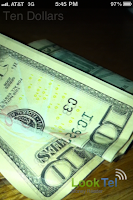 I tried to think about ways to fool the app. Rather than trying to identify a $10 note, I tried folding it to make the “10” look like something else. No matter what I tried, Money Reader identified it as a $10 note. A small pile of notes were also identified. Money Reader was also able to identify the last three generations of small $20 notes and a $2 note with a stamp and postmark from 1976. No matter what I tried to do, I could not confuse Money Reader.
I tried to think about ways to fool the app. Rather than trying to identify a $10 note, I tried folding it to make the “10” look like something else. No matter what I tried, Money Reader identified it as a $10 note. A small pile of notes were also identified. Money Reader was also able to identify the last three generations of small $20 notes and a $2 note with a stamp and postmark from 1976. No matter what I tried to do, I could not confuse Money Reader.
When I started to test Money Reader, it was during the day and the sun was out. The room I was in had the shades open. A few moments later a storm began rolling and and the room darkened. Money Reader was able to continue working after turning on the LED “flash” on the reverse of the iPhone 4. Obviously, this will be a problem for those using the iPhone 3Gs and iPod Touch that does not include the reverse LED.
I tried to identify multiple notes laying on a table or held in my hand. With similar notes, it was difficult to tell which note it was identifying. I used a set of $5 and $1 notes. While flipping the folded notes in my hand, Money Reader would identify the $1 I had just flipped and not the $5 note on top. It would be nice if the app could highlight or somehow indicate which note is being identified. When I made this comment to Mr. Yang, he said this is a planned future enhancement.
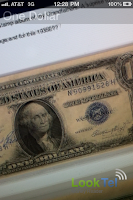 On a whim, I pointed Money Reader at my computer screen with an image of a $1 Silver Certificate. To my surprise, Money Reader identified the blue-sealed note properly!
On a whim, I pointed Money Reader at my computer screen with an image of a $1 Silver Certificate. To my surprise, Money Reader identified the blue-sealed note properly!
Money Reader is fast, accurate, and easier to use than EyeNote. It does not need instructions as EyeNote does because it just works. I love apps that just work! I also cannot believe that the app is $1.99—it is worth every cent and more! I grade this app PR69+. As we numismatists know, proof coins are specially made coins with high quality dies and planchets. Money Reader gives the appearance of specially made software of a very high quality justifying the PROOF grade. Money Reader gets the plus rating because of its superior performance and providing the “that’s neat” response. The slight confusion in identifying multiple notes in front of the camera prevents me from giving it a perfect PR70.
Here are the screen images of Money Reader I saved from my iPhone:
Apr 21, 2011 | currency, foreign
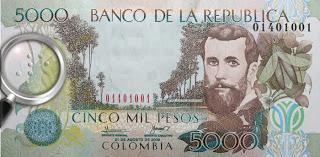 In March, the Banco de la Republica Colombia began circulating new 5,000 peso banknotes with the addition of the number 5 in Braille on the left side of the note. The Braille “5” is the only addition to the note that retains the previous design and security features.
In March, the Banco de la Republica Colombia began circulating new 5,000 peso banknotes with the addition of the number 5 in Braille on the left side of the note. The Braille “5” is the only addition to the note that retains the previous design and security features.
News stories from Colombia report that the COL$50,000 note include the number “50” in Braille in the bottom left next to the serial number. The COL$2,000 note includes the number “2” in Braille in the same location as the new COL$5,000 note.
The Colombian Central bank reports that it will be updating the rest of their banknotes to include the Braille numbers.
Colombian $5,000 note image courtesy of La República
Apr 20, 2011 | commentary, currency, policy, video
Should the United States stop producing $100 bills? According to Timothy Noah, a senior writer at Slate and contributor to CBS Sunday Morning, thinks so. Here is the report that Noah filed for CBS Sunday morning on April 3, 2011:
While a compelling argument but it is not a viable one. Because the U.S. Dollar is the most stable currency even considering our current economic situation, $100 notes will be hoarded overseas and will continued to be counterfeited. It has been reported that rogue nation states like North Korea have successfully counterfeited the $100 note which is why the Bureau of Engraving and Printing is working on its redesign. Having these note continue in circulation could endanger the U.S.
Further, it is doubtful the European Union will discontinue the $euro;500 note even though it is nicknamed “the Bin Laden.” The EU central bank would love to have the euro become the standard currency, the currency all economies are based. It would give more clout in the world markets and provide more incentives for the EU bankers to convince the worldwide commodity markets to price their goods and trade in euros, not dollars.
It is a different world from 1969 when the U.S. government ceased production of the $500 note. Between new counterfeiting measures and the technology to better investigate criminals, the U.S. Secret Service is better able to bring counterfeiters to justice and work with other law enforcement organizations to stop criminals. It is not a perfect system, but making any move that could lower the U.S.’s financial status with the rest of the world will not be well received in Washington.
Mar 4, 2011 | coin covers, coins, currency
Let’s do something different. Let’s talk collecting!
I am finding quite a few 2011 coins in pocket change. Most of my finds are Lincoln cents, but there have been a few 2011-P nickels mixed in. For the first time, I found 2010 dimes in change. I have yet to find any America the Beautiful Quarters® in change. Finding 2011 coins in pocket change this early is a good sign, until oil prices rise and put us back into the “Big Recession.”
In recent years, I have purchased the $2 Single Note Collection from the Bureau of Engraving and Printing. I don’t collect the notes from all of the Federal Reserve branches, I only collect the ones from the Federal Reserve Bank New York. The $2 Single Note Collection features a Series 2003A Federal Reserve note with a a serial number beginning with “2010xxxxD” in a special holder. During the pre-release period, the BEP will only sell the 2011 $2 Single Note Collection as a set. They will begin to sell the individual notes on March 15.
Last week, I purchased the 2010 Presidential $1 Coin Covers. I have been buying U.S. Mint coin covers since they were first released in 1999 for the 50 State Quarters. I find these very cool collectibles and have enjoyed showing them off. They are not popular with collectors and do not sell well in the secondary market, but I like them. To store and display them, I use a two pocket first day cover page stored in a loose leaf binder with anticorrosion pages in the front and back of the book.
I did not buy the 2010 annual sets. The proof sets contain 14 coins and the mint set has 28 coins. Because of the number of coins, the prices for these sets are high. I am not sure it is worth the price since since I collect uncirculated and proof coins in various blue albums and feel that these sets are redundant collectibles. Up until now, I was collecting mint and proof sets dating back to my birth year. But I am not sure I want to continue. I may stop collecting these sets and sell off the collection except for my birth year and the 1965-67 Special Mint Sets.
In fact, I was looking at my collection and may sell a lot of it to just concentrate on my date-mintmark collection, U.S. Mint First Day Covers, interesting world Philatelic-Numismatic Covers (PNC), and some other smaller specialized collections. The rest may end up on eBay!
Speaking of Maryland Colonial currency, I have seen buyer-friendly prices on different auction websites. I wonder if the lack of activity is because of the economy or general interest. For collectors, this is good since we can buy what we want at a good price with a potential for a good future return.
Jan 23, 2011 | currency, history
I think I may adjust my 2011 collecting goals to finding representative notes of Maryland colonial currency from each emission. While searching an popular online auction website, I found a listing for a note that needed to “come home.” This note did not look like it was in as good condition as my previous purchase, but it looked good enough to represent a new emission.
 With money in demand, the Maryland Colonial Assembly authorized an emission of $318,000 in indented bills without legal tender status that would be issued as loans which came due between October 10, 1781 and April 10, 1782. The dollar was tariffed at 4/6 sterling or equivalent in gold or silver. These notes were similar to the release of 1767 except they listed the printers as A.C. and W. Green (Anne Catherine Green and her son William). Jonas Green, Anne’s husband, had died three years earlier. Each bill had two signers, who were Robert Couden, an Annapolis dry goods merchant and mayor of Annapolis from 1786–87, and John Clapham, a landowner in western Maryland who served as sheriff (tax collector) of Anne Arundel County (Annapolis) from 1770–72. These two went into private business together in 1772.
With money in demand, the Maryland Colonial Assembly authorized an emission of $318,000 in indented bills without legal tender status that would be issued as loans which came due between October 10, 1781 and April 10, 1782. The dollar was tariffed at 4/6 sterling or equivalent in gold or silver. These notes were similar to the release of 1767 except they listed the printers as A.C. and W. Green (Anne Catherine Green and her son William). Jonas Green, Anne’s husband, had died three years earlier. Each bill had two signers, who were Robert Couden, an Annapolis dry goods merchant and mayor of Annapolis from 1786–87, and John Clapham, a landowner in western Maryland who served as sheriff (tax collector) of Anne Arundel County (Annapolis) from 1770–72. These two went into private business together in 1772.
This note has a few condition issues that give it the character of surviving 241 years. Aside from the softness of the paper from handling, the center has a fold that is beginning to tear from the bottom and the bottom right corner (obverse) is torn to almost coming off. But the printing is still clear including the signatures of two Maryland patriots.
One of the interesting features of this note is the “J G” included in the right leaf on the reverse of the note for Jonas Green. Green’s influence can also be seen on the obverse of the note on the left border that says “JG Printer · T Sparrow, sculp.” These notes were sculpted by Thomas Sparrow, a Maryland artist who provided most of the border cuts for Maryland colonial currency.
Those who study the history of colonial currency are quick to note that Maryland notes declare that they “shall entitle the Bearer hereof to receive BILLS of Exchange payable in LONDON, or Gold and Silver, at the rate of FOUR SHILLINGS AND SIX PENCE sterline per Dollar for the said BILL.” Notes issued by the Maryland Colonial Council were backed by the profits of Calvert family whose head was Frederick Calvert, the Sixth Lord of Baltimore.
Frederick Calvert was somewhat of a ladies man after becoming the Sixth Lord of Baltimore and Fourth Proprietor of Maryland at the age of 20 in 1751. Aside from having several mistresses, one who published a scandalous autobiography in 1768, he was accused of abducting and raping Sarah Woodcock in London. Although Calvert was acquitted after claiming the encounter was consensual, Calvert escaped to Europe looking to escape his notoriety. Calvert eventually died in Naples in September 1771.
During this time, nobody spoke for the Calvert family and the Maryland assembly continued to freely use the family’s holdings as collateral for these indented bills. Even though Frederick Calvert’s will left the entire Calvert estate to his oldest son, Henry Harford, Harford was only 13 and did not have influence over the assembly’s working even though he was welcomed as the Fifth Proprietor of Maryland. Since Harford was the illegitimate child of Calvert and Hester Whelan of Ireland, Harford was not entitled to ascend to become Lord of Baltimore making Frederick Calvert the last Lord of Baltimore.
Eventually, Harford’s Maryland holdings were seized during the Revolutionary War and used to help fund the government and the Maryland regiments. Harfod returned to Maryland in 1883 and attempted to reclaim the land. Petitions to the Maryland General Assembly failed. His heirs fought for more than 100 years to reclaim the family property. The last case was heard by the U.S. Supreme Court in 1899. In Morris v. U.S., the court denied the family’s claim.
Isn’t it great how one note can open up a segment of history that is not included in your high school history books?!
Click on image to see a larger version.
Jan 20, 2011 | currency
Last year, I wrote an article about the currency issued by the Maryland colony in the 18th century through the end of the Revolutionary War that was published of the Maryland Numismatist, the quarterly publication of the Maryland State Numismatic Association (MSNA). I became interested in Maryland colonial currency after stumbling over the Numismatic Collection in the Department of Special Collections at the University of Notre Dame and reading about Maryland currency on their Colonial Currency page.
Discovering this information about Maryland Colonial Currency inspired me to do more research. The result was a presentation (PDF) I gave to my coin club. I was then asked to convert the presentation to an article that was published in the Spring 2010 edition of the Maryland Numismatist. It was selected as “Article of the Year” by the MSNA.
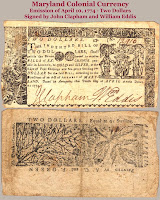 After doing this research, I realized I did not own a piece of Maryland currency. After reading that some people were finding bargains during the holiday time period at one large auction house, I decided to spend my holiday gift money buying a Maryland note. I bid on a few notes hoping to win one. At the end of the auction, I won two notes!
After doing this research, I realized I did not own a piece of Maryland currency. After reading that some people were finding bargains during the holiday time period at one large auction house, I decided to spend my holiday gift money buying a Maryland note. I bid on a few notes hoping to win one. At the end of the auction, I won two notes!
The notes I won are two-dollar and eight-dollar notes from the April 10, 1774 emission. These note were authorized by the Maryland Colonial Assembly. They authorized an emission of $480,000 of non-legal tender bills to be dated and issued on April 10, 1774. This emission. would be the last colonial issue before the Revolutionary War. The authorization was for $266,666 to pay loans, $80,000 for government expenses, and $133,334 to be exchanged for worn bills payable from October 10, 1785-April 10, 1786 at the rate of 4/6 sterling per dollar. An act of October 17, 1780 changed the exchange rate for all currency issued before 1776 to forty old dollars for one new dollar to be redeemed by March 20, 1781, after which all colonial notes were voided.
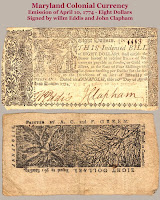 Designs and denominations were similar to the March 1, 1770 issue. Anne Catherine and William Green printed these notes. Anne Catherine Green, whose name appears at “A.C. Green” on the note, took over the business following the death of her husband Jonas Green. Anne Green had to use her initials because it was not acceptable for a woman to be working as a printer in the 18th century. William was Anne’s oldest son. The notes were originally designed by Thomas Sparrow who created the border cuts for these notes. Numismatists studying coinage attempts for the government formed under the Articles of Confederation knows that Sparrow was involved in one attempt.
Designs and denominations were similar to the March 1, 1770 issue. Anne Catherine and William Green printed these notes. Anne Catherine Green, whose name appears at “A.C. Green” on the note, took over the business following the death of her husband Jonas Green. Anne Green had to use her initials because it was not acceptable for a woman to be working as a printer in the 18th century. William was Anne’s oldest son. The notes were originally designed by Thomas Sparrow who created the border cuts for these notes. Numismatists studying coinage attempts for the government formed under the Articles of Confederation knows that Sparrow was involved in one attempt.
In order to make these notes legal to issue they had to be signed by authorizing agents. The agents who signed these notes were John Clapham and William Eddis. Clapham was a landowner in western Maryland who served as sheriff (tax collector) of Anne Arundel County (Annapolis) from 1770–72. Eddis was a British loyalist, born in England about 1745, worked for Colonial Governor Sir Robert Eden as the office of surveyor of customs. Eddis fled to England in 1777.
For being nearly 237 years old, these notes are in fantastic condition. Considering what the reference books say the notes should cost, I can say that I did very well with this purchase. It is a great way to start the new numismatic year!
Click on any image to see a larger version.
Dec 8, 2010 | BEP, currency, Federal Reserve
 Following up on something reported here in October, mainstream media has caught up with the news that the Bureau of Engraving and Printing and the Federal Reserve will delay the release of the redesigned $100 Federal Reserve Note because of production issues. The announcement said that the BEP has identified a problem with sporadic creasing of the paper during printing of the new $100 note that did not appear during pre-production testing.
Following up on something reported here in October, mainstream media has caught up with the news that the Bureau of Engraving and Printing and the Federal Reserve will delay the release of the redesigned $100 Federal Reserve Note because of production issues. The announcement said that the BEP has identified a problem with sporadic creasing of the paper during printing of the new $100 note that did not appear during pre-production testing.
What added to the urgency was the report that the BEP said that about one-third of the 1.1 billion notes produced for the formal release may be creased and otherwise not usable. BEP is attempting to salvage what it can from the previous production run.
Sources confirm that these new notes are the most expensive to produce at 12-cents per note. Production costs using the older paper was 7-cents per note.
The BEP is working with Crane & Co., the exclusive currency paper supplier since 1879, to resolve the issue.
Oct 30, 2010 | currency, history, video
Since 1879, Crane & Co. has been the exclusive currency paper supplier to the Bureau of Engraving and Printing. The company was founded in 1801 by Zenas Crane. Crane, the fourth son of Liberty Paper Mill’s owner Stephen Crane, knew he would not be able to take over the family visit. After learning about paper making, Zenas moved to Dalton, Massachusetts and founded his own mill.
According to CNN Money, Crane & Co. became the supplier of currency paper to the BEP by applying business practices that would not be tolerated today* outbidding other potential bidders:
In May 1879, Zenas’ son, W. Murray Crane was in Washington, D.C., and heard that the Treasury Department was unhappy with their paper currency supplier and was accepting bids for the business.
After all the bids were submitted, Murray learned the amount of the lowest bid and raced back to his hotel room to prepare a second, much lower bid, says Crane historian Peter Hopkins. When the other bidders heard about Crane’s plan they locked him in his room, according to the story, but he managed to slip out and get his bid in just in time. Ever since, Crane & Co. has manufactured the U.S. currency paper.
Today, Crane & Co. is providing the currency paper for the new $100 note with technical features not found on any other note in the world. Interestingly, Crane & Co. is owned and managed by the eighth generation of the Crane family and continues to survive using its currency paper and stationary business.
The following video interviewing Crane & Co. CEO Charles Kittredge about the company’s history and the current economic climate for paper appeared in the Small Business Section of CNNMoney.com:
* CORRECTION: I was contacted by Peter Hopkins, who was quoted in the CNN story. He pointed out to me that while the CNN story may have made the practice of submitting a last minute bid was not exactly ethical, the telegram Murray Crane sent back to Crane & Co. noted that up to three bids could be submitted. Thus, Murray Crane was acting in accordance with the rules while his competitors were not acting professionally. I apologize for the error and corrected the story.
Video courtesy of CNN Money.com
Oct 6, 2010 | counterfeit, currency
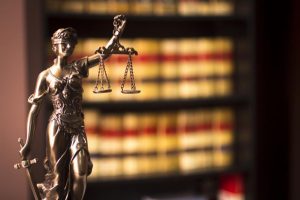 We start our look at the police blotter by reporting that FBI officials in New York reported that they arrested a Manhattan-based jeweler for allegedly robbing noted dealer Julian Leidman. Leidman estimated that 90-percent of his inventory has been recovered of an estimated $1 million worth of coins. Leidman’s car was broken into while he stopped at a restaurant in Montville, NJ on the way home from a show in Stamford, Connecticut.
We start our look at the police blotter by reporting that FBI officials in New York reported that they arrested a Manhattan-based jeweler for allegedly robbing noted dealer Julian Leidman. Leidman estimated that 90-percent of his inventory has been recovered of an estimated $1 million worth of coins. Leidman’s car was broken into while he stopped at a restaurant in Montville, NJ on the way home from a show in Stamford, Connecticut.
ELKHART, Indiana—Police are warning business that someone is passing counterfeit $100 notes. All notes are using the same serial number (HE88210403B) and appear realistic. What is worrying police is that the bills are not responding to counterfeit detection pens, suggesting the notes were probably printed on bleached lower denomination notes. Police are suggesting that merchants check “100” in the lower right hand corner for color shifting ink. It is being reported that the same notes are showing up across the border in Dowagiac, Michigan.
DANBURY, Connecticut—Police arrested two Brooklyn, NY men for passing $700 worth of $100 notes at Danbury Fair Mall on Sunday. A third suspect allegedly got away. The men attempted to pass these notes for small purchases, usually less than $10, but raise the suspicion of a clerk who called the police. When arrested, one of the men was in possession of two counterfeit $100 notes and marijuana. Another was arrest with more counterfeit notes while trying to shoplift at another store. Both men are being held on $45,000 bonds.
ALLEN PARK, Michigan—According to a criminal complaint filed in the United States Attorney for the Eastern District of Michigan, a man was arrested for counterfeiting $100 notes in a local hotel room. The alleged perpetrator was buying household chemicals at a local store and using them to bleach $5 notes. The notes were then printed using a printer in the room. When the police arrested the man they found 49 counterfeit $100 notes and eight bleach $5 notes. The man arrested said that he was going to use the money to buy large amounts of marijuana for resale.
SALISBURY, Maryland—A Virginia woman is in custody for passing counterfeit notes to several Salisbury businesses. Janet Perrin, 27, was extradited from Fairfax, VA on a warrant charging her with three counts each of possession of counterfeit money and manufacturing counterfeit money. It has been alleged that Perrin passed more than 10 counterfeit $100 notes.
Also in Salisbury, Maryland, it was reported that Shawn L. Brown, 35, was arrested and charged with counterfeiting currency and indecent exposure on September 20 by Maryland State Police. No further information has been published.








 We start our look at the police blotter by
We start our look at the police blotter by 